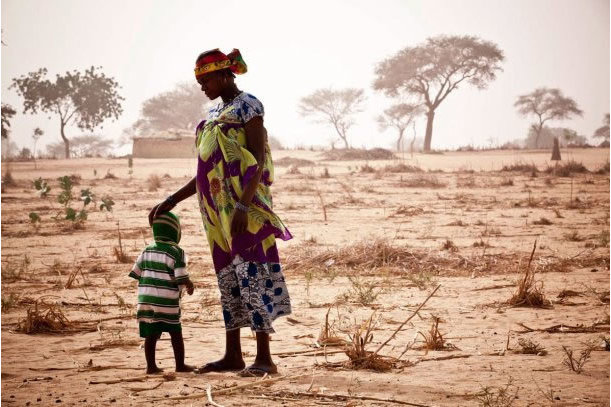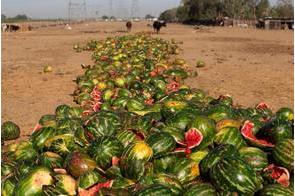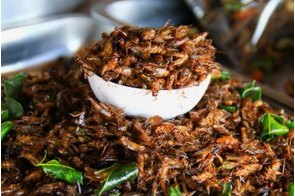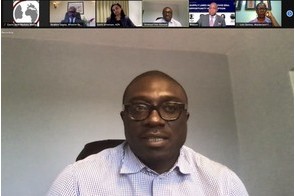Food security in Nigeria and the world by 2050

Summary
Through agricultural R&D investment, the population at risk of hunger can be reduced by nearly a quarter by 2030.
According to a recent United Nations report, Nigeria's population will surpass that of the United States by 2050, to become the third most populous country in the world. Over the next 33 years, Nigeria, which is currently the world's seventh most populous country and growing the most rapidly, is expected to see its population reach 398 million people in the middle of the century.
Like many other developing countries, Nigeria has experienced a shortage of food supplies due to economic instability, severe drought and persistent conflicts. Constant increases in food prices have also deprived many households of three-square meals per day.
As a biochemist, working on food safety and food security, I am deeply worried about the current and future availability and affordability of food in the world, especially in Nigeria and the developing world. Food safety should particularly be a top agenda for African countries because five of the nine countries predicted to contribute to more than half of the world's population by 2050 are on the African continent. These comprise Nigeria, Democratic Republic of Congo, Ethiopia, Tanzania and Uganda.
To feed the future population, which the UN has projected to reach 9.8 billion in 2050, the agriculture sector needs significant long-term public spending and private investment so that we can improve the technologies to grow food. Some of the areas in which advancements in technology is crucial include irrigation, and prevention of food loss and waste. The current spate of short-term and low investment in agricultural research and development (R&D) has a glaring implication – which is stagnant production and low productivity.
Public and private sector agricultural R&D can lead to development of new crop and livestock production technologies, significantly increasing the quantity and quality of agricultural output per unit of labour, land and other resources in low-income countries. This measure of efficiency of inputs in the production process is called Total Factor Productivity (TFP).
According to the International Food Policy Research Institute (IFPRI), R&D investment strategies that increase agricultural TFP from the current estimate of 1.6 percent per annum to 2 percent can lower the global prices of cereals and meat by as much as 17 and 15 percent, respectively. Crop production area can also be increased by 2.4 percent and crop yield by 8.5 percent by 2030. Through agricultural R&D investment, the population at risk of hunger can be reduced by nearly a quarter in the same period.
Drought, a central challenge to food production, is getting worse. Many regions in the Middle East, Asia, Africa and other parts of the world are experiencing abnormally low rainfall, higher surface-air temperatures and drier air for longer periods. While droughts can have different causes, one major cause is climate change. This is because as more greenhouse gases such as carbon dioxide, methane and nitrous oxide are released into the atmosphere, causing air temperatures to rise and more rapid evaporation of moisture from water bodies. Higher temperatures also increase evaporation of moisture from soils, reduce rainfall and eventually cause droughts.
Africa must strategically develop advanced irrigation systems. Seventeen countries in East and Southern Africa are suffering as a result of two consecutive years of droughts that have rendered many farmers unproductive, caused scorched harvests and left more than 38 million people at risk of hunger this year.
We have seen alarming increases in food prices and food shortage as a result of drought in Ethiopia, Kenya, Angola, Burundi, Eritrea, Djibouti, Madagascar, Lesotho, Malawi, Somalia, Sudan, Swaziland, Tanzania, Rwanda, Mozambique, Uganda and Zimbabwe.
The current situation calls for less reliance on rainfall for food production. Irrigation systems allow farmers to augment the amount of water supplied to plants at regular intervals to aid crop growth and re-vegetation of dry areas during periods of inadequate rainfall. This is especially important because the Food and Agricultural Organisation of the United Nations (FAO) estimates 60 percent of food supplies will come from irrigated agriculture.
We can look to Israel for proof that countries facing dry climates can innovate to overcome drought challenges. Israel has developed technologies from improved drip irrigation system, to the use of natural pesticides for food production. MASHAV, Israeli's Agency for International Development Cooperation, is one of the several institutions through which many technological advancements have been birthed.
In addition to improved drip irrigation system and a water technology that channels dew from the air to the roots of plants, experts from Israel have also created better grain cocoons/bags and biological pest control. Moreover, they have developed new potatoes for hot and dry climate.
Although several factors may have contributed to Israel's wealth (unemployment rate was 4.5 percent in May 2017), investment in improved technologies is clearly a dominant factor. It is, however, surprising that with a population of 8.6 million in 2016, 1.7 million people (21.7 percent of the population), including 460,800 families, live below the poverty line in Israel. Nevertheless, this estimate is very low when compared to Togo, a country with a smaller population (7.6 million) but has a poverty rate of 58 percent and 29.7 percent of children under age five are chronically malnourished.
Another major pitfall to food security in developing countries, including Nigeria, is poor storage systems and lack of processing capacity. For instance, in Nigeria, a tomato farmer who finds it difficult to sell his entire 600 baskets of tomatoes soon after harvesting may end up losing a huge sum of money because he has no way of storing or processing them to avoid spoilage. This loss of food accounts for some of the increase in price of food commodities, as farmers look to cover their losses one way or another.
Food loss is not limited to tomatoes or vegetables and fruits. It also affects maize, a staple food in many developing countries, as well as beans, which are the most affordable sources of plant protein in many developing nations. Insects also contribute to post-harvest food losses. Hence, farmers and traders use pesticides to try to prevent weevil infestation in crops post-harvest and before taking them to the market.
Reducing food loss and waste (FLW) is a global challenge. In India, about 40 percent of the total agricultural produce is lost along production and supply chains every year. A 2013 estimate found that food that is thrown away in China every year could feed 200 million people. The FAO has reported that one-third of the food produced in the world for consumption gets lost or wasted every year. This is approximately 1.3 billion tonnes of food. Globally, 40-50 percent of root crops, fruits and vegetables are lost or wasted. 30 percent of cereals grown is lost; 20 percent of oil seeds, and 35 percent of fish produced are lost or wasted. Meanwhile, people continue to go hungry in the presence of plenty.
The problem of food loss and waste is not limited to developing countries. While food loss at the production and post-harvest stages is common in developing countries, food waste at the retail and consumer levels is more prevalent in developed countries. According to FAO, industrialised countries such as the United Kingdom, Germany, Malaysia, Singapore, Finland, the United States of America, among others, waste up to 670 million tonnes of food annually while developing countries account for about 630 million tonnes in food losses.
To truly understand the scale of food loss and waste, one must consider that the food currently lost in Africa can feed 300 million people. Food currently wasted in Europe can feed 200 million people, while the food currently lost in Latin America can feed 300 million people. If the world is serious about having enough food to feed the estimated 9.8 billion world population by 2050, then governments should urgently find ways to save the available food.
The world's population is growing rapidly and Africa is at the forefront of this expansion. If we want to be able to feed this growing population, we must do better. We need to start to look at how we grow our crops, and specifically how we do so in the face of increasing droughts. We also need to address how we handle our food from when it's harvested to when it's consumed. If we don't, the world's population would be left in poorer health, greater inequality and more conflicts.
Financial Nigeria Columnist, Mojisola Ojebode, is a Nigerian biochemist and the founder and product developer at Moepelorse Bio Resources. She is also a Global Innovation Through Science and Technology (GIST) awardee, and an Aspen New Voices fellow.
Related
-
Food security in Nigeria and the world by 2050 II
Despite the support from international organisations to drastically reduce food losses and wastage in developing countries, ...
-
Edible insects as sustainable alternatives to livestock products
A paradigm shift from livestock to insects will go a long way to limit the impacts of climate change globally. The less ...
-
Stakeholders discuss financing and food security for post-COVID-19 Africa
AZA, MasterCard and Afreximbank and beneficiaries including Nigeria’s Alluvial Agriculture showcase collaborations.







